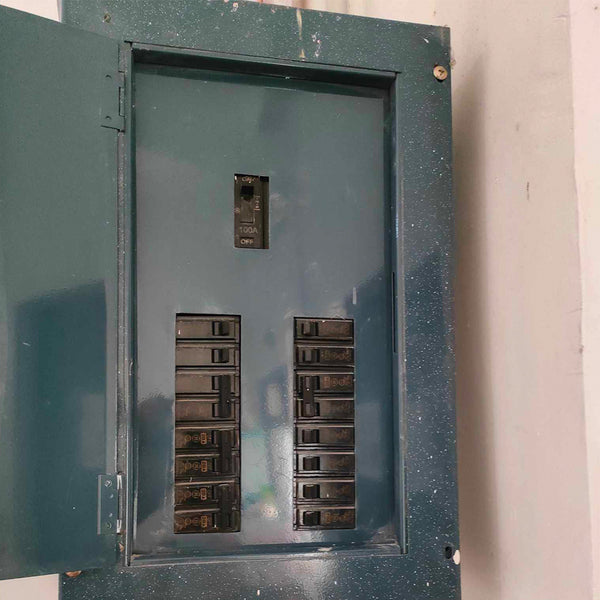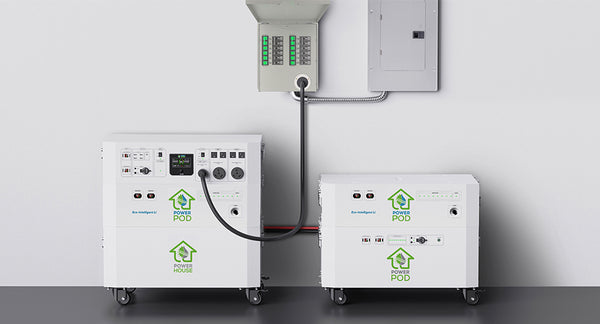An electrical panel, commonly known as a breaker box, is an important component of your home’s electrical system. It is often overlooked but crucial for regulating the flow of electricity in your homes. Think of it as a “silent manager” of your home's electricity distribution, ensuring safety and efficiency. Given its importance, understanding its role and function is a must for every homeowner, especially those considering integrating solar panels into their energy infrastructure.

So What is an Electrical Panel?
The main function of an electrical breaker box is to serve as the central hub where the electricity from the utility company enters your home and is distributed to various circuits.
To locate your breaker box, look for a mounted metal box, usually in gray and typically located in your basement, garage, or utility room. Most houses only have a single electrical panel, but some may have subpanels, especially those houses with multiple living units. If you look inside, you’ll find:
- Main Electrical Panel - Positioned at the top, this switch controls the power supply to the entire house. It also indicates the amperage of your electrical service. It can be turned off during emergencies or maintenance.
- Circuit Breakers - These smaller switches regulate electricity flow to individual circuits, each responsible for a specific area of your home, and should be labeled for easy identification. They trip automatically when overloaded to prevent electrical hazards.
- Bus Bars - Metal strips inside the panel that distributes electricity from the main breaker to circuit breakers, serving as the connection point for all wiring in your home.
- Fuse boxes – some older houses may still have this instead of the breaker panels. They serve the same function, but blow fuses need replacement. They are less common in modern homes due to their limited capacity.
electrical panel also come in various sizes, measured in terms of the amperage (amp) they can handle. Here's a breakdown of common electrical panel sizes and their corresponding amperage ratings:
- 60 Amps (for fuse boxes) - Found in homes built between 1950 and 1965, these older fuse boxes typically provide a maximum of 60 amps of power, often with just four fuses.
- 100 Amps - Considered standard for many homes, a 100-amp electrical panel is suitable for average household electrical needs. However, with the increasing demand for electrical appliances and devices in modern households, 100 amps may be insufficient for larger homes or those with high-energy requirements.
- 150 Amps - Homes that frequently run multiple appliances simultaneously, such as air conditioners, washing machines, and electric ovens, may benefit from a 150-amp electrical panel. This higher amperage rating ensures adequate power supply during peak usage times.
- 200 Amps - Recommended for larger homes or properties with heavier energy demands, a 200-amp electrical panel provides ample capacity to accommodate the electrical needs of a typical household.
- 400 Amps - Reserved for large homes with extensive electrical requirements or properties featuring additional workshops, outbuildings, or advanced automation systems, a 400-amp electrical panel offers substantial power capacity. This size is ideal for maintaining smooth operation without the risk of overload or voltage fluctuations.
How Does an Electrical Breaker Box Work?
Each breaker switch within the electrical panel controls a specific electrical circuit in your home. When a circuit becomes overloaded with electrical current (e.g. if more than 150 amps are used in a 150-amp panel), the breaker switch automatically shuts off to prevent damage to electrical devices or the risk of fire. It does so by moving its switch to the middle, (just as how a light switch turns a light on or off.)
To reset things, you just flick the breaker switch off and then on again after unplugging a few appliances to ease the load.
Note that if you’re expanding your house or if you are planning to add heavy-duty appliances like electric vehicles (EVs), you might need to upgrade your breaker panel to handle the extra power.
In addition, if your main breaker keeps tripping, it’s a sign you need an upgrade. It could set you back $1,500 to $3,000 to go from a 100-amp to a 200-amp panel. Make sure to hire a licensed electrician for any upgrades for safety purposes.

Incorporating Solar Panels
Homeowners can optimize energy efficiency, reduce reliance on traditional power sources, and contribute to a more sustainable energy future by integrating solar panels into their home electrical systems.
Solar panels produce direct current (DC) electricity, which is converted to alternating current (AC) using an inverter installed near the electrical panel. The output from the solar panels connects to the electrical panel, merging with utility-supplied electricity. A dedicated breaker may regulate the flow of solar electricity into the home. Excess solar energy can be sent back to the grid through the electrical panel (net metering), allowing homeowners to earn credits for the surplus energy generated.
Also, make sure that the size of the breakers for breaker box matches the additional power generated. For example, if you have a smaller solar installation, a 100–150-amp panel can support the generated electricity from solar without overloading the system.
If you are considering integrating solar power into your home, one of the industry’s leading and trusted providers is Nature’s Generator. They offer a wide selection of products tailored to match your needs. One standout option is Nature’s Generator Powerhouse , which boasts a maximum power output of 120V/240V 7200Watt, capable of single-handedly fulfilling all your power requirements. It can also use both SLA and LiFePO4 battery-technology power pods to further expand system capacity. For more information and to assist you in determining the right solar system for your home, feel free to get in touch with the Nature's Generator team here.
Final thoughts
Understanding the function and operation of your home's electrical panel is crucial for maintaining a safe and efficient electrical system. With the integration of solar panels, homeowners can enhance energy efficiency and contribute to a more sustainable energy future, all managed from the central hub of the electrical panel.
* We want to give credit where credit is due. Professional writer, Michelle Ann Gamana, contributed research and content to this blog titled: What is an Electrical Panel Thank you, Michelle, for your contributions!













